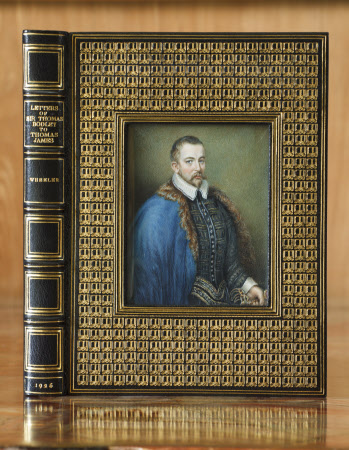Letters of Sir Thomas Bodley to Thomas James, first Keeper of the Bodleian Library / edited with an introduction by G. W. Wheeler.
Sir Thomas Bodley (1545-1613)
Category
Books
Date
1926
Materials
Place of origin
Oxford
Order this imageCollection
Anglesey Abbey, Cambridgeshire
NT 3151007
Summary
G.H. Wheeler (ed.), Letters of Sir Thomas Bodley to Thomas James, Oxford: Clarendon Press, 1926. Binding: Twentieth-century full dark blue morocco Cosway binding over boards; upper cover gilt with tool showing open book on stand; inlaid with portrait of Bodley painted on ivory, protected by glass; gilt spine; sewn onto five raised bands; gilt fillets on turn-ins and board edges; gilt-lettered board edges: Cosway binding / Invented by J.H. Stonehouse; gilt top edge; dark blue watered-silk endleaves. Binder's stamps: Miniatures by C. B. Currie. Bound by Riviere & sons.
Full description
A ‘Cosway binding’ is the name given to a distinctive style of bookbinding, created around the turn of the twentieth century, devised to appeal to wealthy collectors who wished to indulge in some ostentatious luxury. These bindings were made of the best materials and elaborately gilt-tooled, with the defining finishing touch of a hand-painted miniature inlaid at the centre of the front cover. The miniatures were individually made for each book, and typically depicted the subject or author. The style was invented and named by the London bookselling firm of Sotheran's, and numerous examples were offered for sale in their catalogues during the first four decades of the twentieth century. The earliest known one dates from 1902, and by 1930 it was claimed that over 900 such bindings had been made. The name was inspired by the English artist Richard Cosway (1740-1821), who was famous for his portrait miniatures. Sotheran's commissioned the bindings from several top firms of the day, including George Bayntun, Sangorski & Sutcliffe, and Robert Rivière & Son, and the miniatures, painted on ivory, were the work of Miss C.B. Currie, who also specialised in adding fore-edge paintings to bindings. Prices typically varied between £20 and £60, depending on the elaborateness of the binding. To modern eyes, these bindings seem aesthetically clumsy, the triumph of ingenuity (and expense) over good taste, but they had a following at the time. According to Sotheran's catalogue 812 (1928), they ‘take a long time to produce, but they sell very quickly’. Lord Fairhaven was evidently taken by them, as there are 15 on the shelves at Anglesey Abbey today. The two illustrated here are representative examples. The ‘Letters of Sir Thomas Bodley’ has a miniature portrait of Bodley inset within boards which are heavily gilt, but to a simple pattern, and overall seems one of the more successful designs achieved with Cosway bindings. ‘The Life of Napoleon’ belongs at the other end of the scale; each volume has a different miniature, copied from famous paintings of scenes from Napoleon's life, set within a frame edged with pearls. Coupled with the elaborate floral design round the outer border, the effect is one of saccharine extravagance. Whether we like them or not, however, they are beautifully preserved examples of this particular slice of early twentieth-century bookbinding history. Text adapted from David Pearson's entry in ‘Treasures from Lord Fairhaven’s Library at Anglesey Abbey’, National Trust, 2013, cat. 46, pp.140-3.
Bibliographic description
xliii, [5], 251, [1] p., [1] leaf of plates : facsims. ; 4to. Provenance: Twentieth-century armorial bookplate small variant, signed Badeley 1930: Urban Huttleston Rogers Lord Fairhaven [i.e.: Urban Huttleston Broughton, 1st Lord Fairhaven (1896-1966)]. Binding: Twentieth-century full dark blue morocco Cosway binding over boards; upper cover gilt with tool showing open book on stand; inlaid with portrait of Bodley painted on ivory, protected by glass; gilt spine; sewn onto five raised bands; gilt fillets on turn-ins and board edges; gilt-lettered board edges: Cosway binding / Invented by J.H. Stonehouse; gilt top edge; dark blue watered-silk endleaves. Binder's stamps: Miniatures by C. B. Currie. Bound by Riviere & sons. Added leaf bound in: "This is No. 847 of the Cosway Bindings invented by J. H. Stonehouse, with miniatures on ivory by Miss Currie. Signed J. H. Stonehouse Inventor. C. B. Currie Artist." [Signatures and number added in ms.] In protective blue cloth slipcase.
Provenance
Acquired by Huttleston Rogers Broughton, 1st Lord Fairhaven (1896-1966) and then bequeathed by him to the National Trust with the house and the rest of the contents in 1966.
Makers and roles
Sir Thomas Bodley (1545-1613), author George William Wheeler (b.1863), editor
References
Mark Purcell, William Hale and David Person, Treasures from Lord Fairhaven’s Library at Anglesey Abbey, Swindon: National Trust; London: Scala Arts & Heritage Publishers, 2013., pp. 140-3
